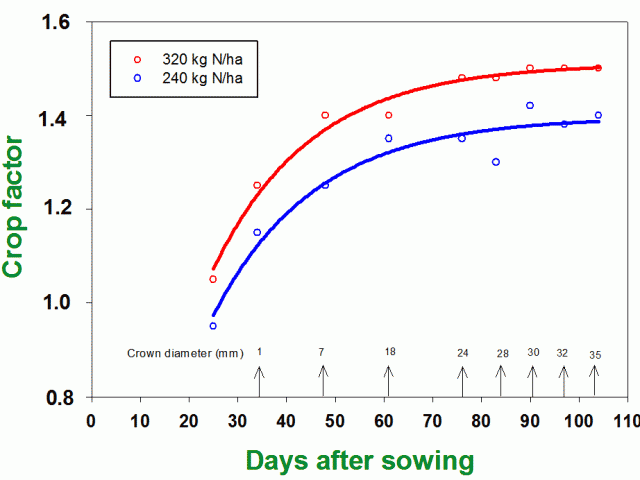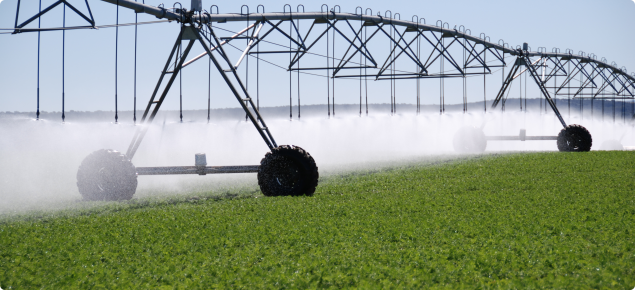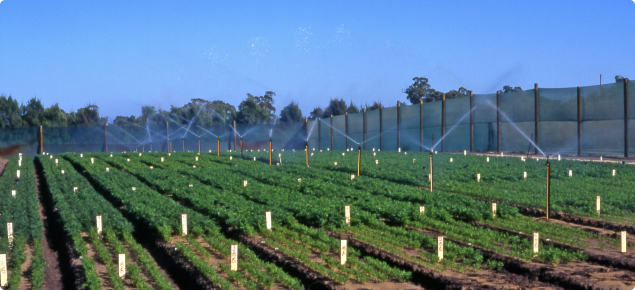Irrigation balance
Under-irrigation will compromise yields while over-irrigation can affect root quality, promote excessive fertiliser use, and possibly result in pollution of groundwater and surface water bodies.
- A 16-week summer carrot crop grown on sandy soil near Perth may require 1000mm of irrigation which is 10 000 kilolitres or 10 megalitres of water per hectare.
- Carrots are relatively salt-sensitive, similar to lettuce, onions and strawberries.
- Two key requirements are an efficient irrigation system and simple scheduling approach.
- The irrigation needed depends on the crop growth stage, soil type, crop vigour and weather conditions.
- Use a crop factor, which varies with crop growth stage, to determine the proportion of evaporation the crop should receive. For example, a crop approaching maturity with a crop factor of 1.3 should receive 1.3 times evaporation.
- Evaporation figures can be supplied from direct measurement from a pan evaporimeter or calculated from weather station data.
- Long-term pan evaporation values (see Figure 2, Tables 1 and 3) can be used to guide irrigation. However, using actual daily evaporation is more accurate.
Using actual daily evaporation figures and a crop factor (from Figure 1) you can calculate the daily water requirement and then the system run time to apply this amount as follows:
Water requirement [mm] = (Crop factor) x (daily evaporation)
Run time (minutes) = (Application rate [mins/mm]) x (Water requirement)
Use soil moisture probes to check irrigation adequacy.
Note that: 1000 litres = 1 kilolitre, 1000 kilolitres = 1 megalitre and 1000 megalitres = 1 gigalitre.
Water quality
Carrots are relatively salt-sensitive, along with lettuce, onions and strawberries.
Ideally, water quality should be below 1.0 deciSiemens per metre or 550mg/L total dissolved salts (TDS). On sandy soils and with frequent irrigation, higher salt levels would be tolerated without yield penalty because soil is not drying seriously between irrigations and it is easy to leach salts below the root zone.
In Western Australia, carrots are irrigated with water generally from 400-800mg/L TDS. In hot weather, germination has reportedly been reduced with irrigation water above 1400mg/L TDS.
The impact of irrigation water quality on carrot yield and quality has not been studied in Australia. It is likely that in some areas yield is reduced by salt in irrigation water but the impact will depend on climate, soil type and irrigation management. Apply additional water to leach salt where water quality is marginal.
Water quantity
Carrots can tolerate dry conditions however moisture stress needs to be avoided to produce high yield and quality. In Australia, carrots are irrigated from groundwater, rivers and dams generally via overhead sprinklers and centre-pivots.
On loamy soils near-mature carrots are irrigated to apply close to evaporation replacement, while on coarse sandy soils up to 1.3-1.4 times evaporation is required once full leaf canopy has developed.
Table 1 shows the average water requirement for a Stefano crop growing in coarse sand near Perth, Western Australia.
| Planting date | Predicted harvest date | Estimated water requirement (mm) |
|---|---|---|
| 1-Jan | 26-Apr | 971 |
| 22-Jan | 25-May | 823 |
| 12-Feb | 25-Jun | 671 |
| 4-Mar | 26-Jul | 549 |
| 25-Mar | 26-Aug | 486 |
| 15-Apr | 23-Sep | 487 |
| 6-May | 17-Oct | 551 |
| 27-May | 8-Nov | 660 |
| 8-Jul | 9-Dec | 870 |
| 29-Jul | 21-Dec | 948 |
| 19-Aug | 1-Jan | 1007 |
| 9-Sep | 12-Jan | 1050 |
| 30-Sep | 24-Jan | 1081 |
| 21-Oct | 8-Feb | 1099 |
| 11-Nov | 26-Feb | 1103 |
| 2-Dec | 20-Mar | 1088 |

Irrigation uniformity
In Australia carrots are usually irrigated from overhead sprinklers, either permanent or semi-permanent impact sprinklers or centre-pivot irrigators.
An efficient irrigation system is vital before any attempt can be made to schedule irrigation efficiently. The system must be capable of applying water uniformly. A measure of system uniformity, called the coefficient of uniformity (CU) can be calculated from a series of catch cans placed under the sprinklers:
CU = [1- (average catch can variation from mean)] x 100
A CU of greater than 85% is considered acceptable.
Irrigation frequency and timing
On loamy soils in cool climates, crops may only require irrigation once or twice per week, while on sandy soils in hot climates carrots may need irrigating twice per day.
To maximise the use of off-peak power in summer, pre-8am waterings can be applied on sandy soils. These waterings should apply no more than 8mm to a crop that has been watered within the previous 24 hours and will usually be limited to less than 6mm to avoid drainage beneath the root zone.
When more that 8mm/day of irrigation is required, this will be applied in two waterings separated by more than four hours. Soil moisture can be monitored with sand (low-tension) tensiometers or some other soil moisture monitoring device suitable for sand.
Application rate
The application rate in milimetres per hour of the system at a given operating pressure must be known. For example, if a system has a output of 8mm/h, it takes a run time of 60/8 = 7.5 minutes to apply 1mm of water.
Irrigation should be scheduled based on evaporation and guided by soil moisture monitoring devices.
Irrigation for crop establishment
During land preparation before planting, water application will be kept to a minimum to minimise leaching losses of residual or mineralised soil nitrogen.
During the early stages of crop establishment, the soil surface needs to be kept moist to ensure even germination and to prevent heat-induced girdling of young seedlings. This is achieved by multiple light waterings on hot days.
During these early stages, total daily water application should not exceed 0.9 of Class A pan evaporation (Epan) to minimise nutrient leaching.
Crop factors
Plants use increasing amounts of water as they grow. To account for this, a crop factor is used to reflect the amount of water the crop uses at a particular age or growth stage.
Crop factors for carrots have been derived from line source experiments on coarse yellow Karrakatta sands at Medina Research Station (HIA project VG95010). Figure 1 shows the crop factors (pan evaporation replacement rates) that produced optimum yields at two nitrogen levels for carrots watered twice per day.
In this case the 240kg N/ha treatment produced greater than 70t/ha root yields and can be considered a crop of moderate vigour. From about 35 days after sowing in late spring/summer, carrot water requirements increase from about 0.8 times pan evaporation to 1.3 times pan evaporation (130% Epan) near maturity for a moderately vigorous crop, and to 1.5 times (150% Epan) for a high vigour (320kg N/ha) crop.
Crop factors for vegetables on sandy soils are high because of the combination of high water use, high vapour pressure deficits in summer and the rapidly declining hydraulic conductivity of the coarse textured soil as moisture content declines.
Irrigation scheduling
A sound approach is to schedule irrigation using average long-term daily pan evaporation rates and crop factors. A more accurate approach is to schedule irrigation based on the previous day’s actual evaporation where these figures are available from live weather stations. Soil moisture monitoring devices should be used in conjunction with irrigation scheduling to monitor the adequacy of applied irrigation. Crop factors for carrots are shown in Figure 1 and summarised for various growth stages in Table 2.
| Crop interval (days after sowing) | Root crown diameter (mm) | Crop factor |
|---|---|---|
| 0-24 | <1 | <0.8 |
| 25–34 | <1 | 0.85 |
| 35-48 | 1-7 | 1.15 |
| 49-61 | 7-18 | 1.25 |
| 62-83 | 18-28 | 1.35 |
| 84 to harvest | >28 | 1.40 |
Calculating crop water requirement
Average daily pan evaporation for each week of the year is plotted in Figure 2 and listed in Table 3. Crop water requirement will be calculated according to the following formula:
Crop water requirement (mm/day) = (Crop factor) x (daily Epan)
Example calculation: Carrot crop has reached 10mm root diameter stage. What is the average water requirement for the second week in November?
Water requirement = 1.25 (from Table 2) x 6.6 (from Table 3)
= 8.25mm/day
These calculated figures will be used only as a guide for irrigation scheduling.
During periods of hotter or cooler than average weather, adjustments to water application will be made and should be guided by soil moisture probe readings from within the crop.
Acknowledgments
This information was originally authored by Allan McKay.




